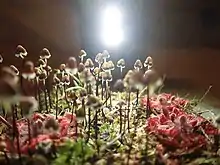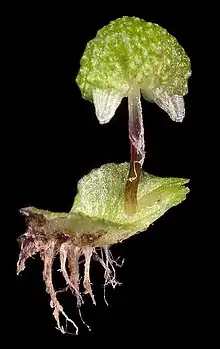Asterella drummondii
Asterella drummondii is a liverwort in the family Aytoniaceae,[2][3] which was first described as Fimbraria drummondii by Taylor in 1846, from material collected by Ronald Gunn in Tasmania, and James Drummond (for whom it is named) in Western Australia from the Swan River.[2][4] It is found in all states of Australia,[5] in semi-arid areas.[6]
| Asterella drummondii | |
|---|---|
 | |
 | |
| Scientific classification | |
| Kingdom: | Plantae |
| Division: | Marchantiophyta |
| Class: | Marchantiopsida |
| Order: | Marchantiales |
| Family: | Aytoniaceae |
| Genus: | Asterella |
| Species: | A. drummondii |
| Binomial name | |
| Asterella drummondii | |
Description
Asterella drummondii is a liverwort occurring on soil crusts or organic material in both wet and dry habitats. The thallus usually has a single tongue-like shape but sometimes appears as a star shaped rosette with a red/black margin, making the species easily found. When the thallus is dry, it rolls up to expose dark wavy margins. The fruiting bodies occur on dark stalks on the surface of the thallus. They hang down and have a white frill on the lower edge.[6]
References
- "Species profile: Asterella drummondii". Queensland Government.
- "Asterella drummondii". Australian Plant Name Index (APNI), IBIS database. Centre for Plant Biodiversity Research, Australian Government.
- Long, D.G. (1999). "Validation of the combination Asterella drummondii". Journal of Bryology. 21: 76. doi:10.1179/jbr.1999.21.1.76.
- Taylor, T. (1846). "New Hepaticae". London Journal of Botany. 5: 412.
- Australia, Atlas of Living. "Species: Asterella drummondii". bie.ala.org.au. Retrieved 26 August 2020.
- "Cryptogram of the month - January 2010" (PDF). 2010. Retrieved 26 August 2020.